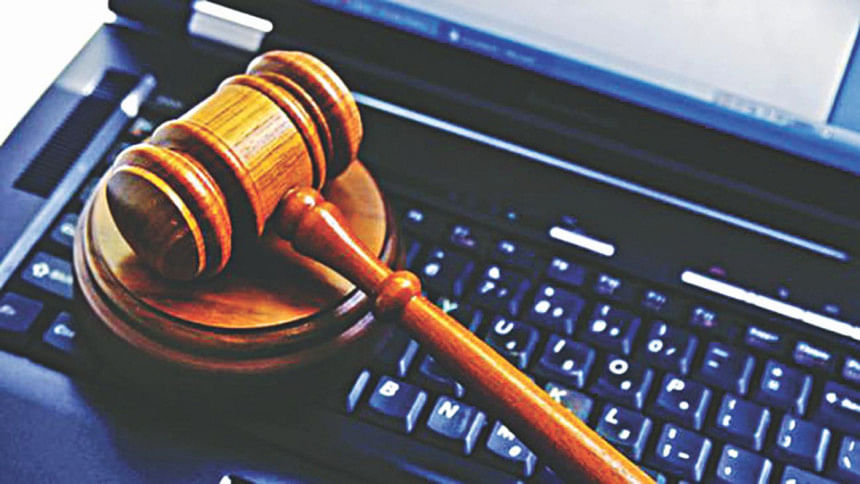Simple technology for a modern Bangladeshi court

MODERN technology, like the internet, has dramatically changed the modes of retrieving information. We expect faster outcomes with less effort. As a result, every sector is being modified to adapt to the changing society. The law is no exception. In the former Chief Justice's words, "the law must assume new dimensions to suit the needs of an IT-based modern society and it should play a dynamic role like a living organ."
In order to keep up with technological advances and remove the backlog of cases, Bangladesh judiciary requires complete digitalisation. This would mean databasing that may take years. But taking simple approaches would provide judges with easy access to legal information and accuracy. All of that, to achieve faster outcomes to save precious court time.
Optical Character Recognition (OCR) and Quick Response (QR) Codes can bring a significant reform in the judiciary of Bangladesh. OCR is a powerful technology that works along with a scanner to convert printed/typed/handwritten documents into digital texts, while QR Codes streamline useful information and allow quick retrieval.
A combination of the two would prove essential in responding to the increased pressure of searching old documents in court.
How would OCR make a difference?
It takes strenuous hours in finding exact provisions from a judgement for both lawyers and judges. They browse through piles of paper with little or no success. Precious time is wasted flipping through page after page.
To save time and energy, OCR provides a permanent solution of extracting written documents to text. Words or letters would be individually recognised by a software and digitally reconstructed. Once they are digitised, one command of "Find" in a computer can search and retrieve any word or sentence in seconds.
In Bangladesh, hundred-year-old deeds are needed to determine the chain of land ownership. Most of these are in a shabby state. Moreover, such records have to be re-written to make them readable. This practice can be replaced by OCR. Any document, be it handwritten or typed using a typewriter, can be converted to a word document or a non-editable PDF.
Can QR Codes save time?
The Quick Response Code (otherwise known as QR Code) is a simple yet powerful designed code similar to a bar code which stores information. To retrieve such information, a person needs to scan it via a smartphone. The software in the smartphone decodes the information. It is mostly used for storing links to websites. It is a great tool for referencing.
QR Codes can be vital in storing legal information or can lead to a database of such. Online platforms provide collection of case laws, law journals or legislation which can be quickly accessed via QR Codes. For example, if link to a particular DLR reference or judgement is contained in a QR Code, it would be easier for judges or lawyers to simply use the code instead of footnotes. That way accuracy can be achieved and the certainty of law would be preserved.
Our judicial system must conform to what prevails in other parts of the world. The "Courtroom 21" in USA aims to "improve the world's legal systems through the appropriate use of technology." It was founded in 1993 which introduced the world's most technologically advanced courtroom in College of William & Mary Law School's McGlothlin Courtroom.
The Miami-Dade County Traffic Division has introduced SPIRIT (Simultaneous Paperless Image Retrieval Information Technology) which makes traffic cases in courts hassle free.
The Supreme Court of India is set to launch its Case Management Information System (ICMIS). It will provide litigants easy access to file cases digitally. It is expected that once the system comes into practice, case records will be electronically picked up by the judges.
A central database system?
In order to run a suit in court, an advocate needs to meet the bench officers who maintain a diary and a "Cause list" from time to time. To check for future dates given by the court, or submit a "Hajira", an advocate has to personally visit or send his/her junior to submit it to that specific court. A Hajira is a document which indicates that all of the parties are present for the hearing of a particular case.
For every Hajira or getting access to the cause list, if a central database is introduced, there will be a major change in this practice. Every chamber inside the court premises would have computers that will be connected to the main server via LAN (Local Area Network). There will be a dedicated software that will notify individual advocates about the future dates in the cause list. It shall also allow remote submission of the Hajira and provide access to relevant information. A central server would provide secure storage for information, accessible only to enrolled advocates having their chambers in and around the court area.
Digitalisation of the courts in Bangladesh is essential in the times that we live in. It would complement the government's ongoing Vision 2021 project and unveil new horizons. The introduction of modern technology would not only save the courts much of their precious time, but would ensure certainty of law.
Aiman R Khan is Apprentice Advocate at Dhaka Judge Court.

 For all latest news, follow The Daily Star's Google News channel.
For all latest news, follow The Daily Star's Google News channel. 



Comments